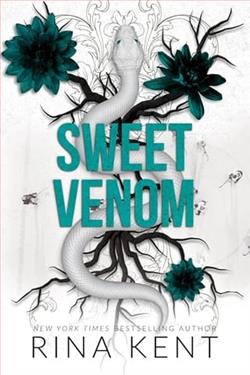Page 51 of Dirty Valentine
We approached carefully and shined our lights behind the feed bags.A woman looked back at us, and my lungs froze with fear and my heart stuttered.
Behind the feed sacks, a young woman was huddled against the wall, her knees drawn up to her chest.Blood seeped through a makeshift bandage on her left arm, and her face was pale with shock.When our lights hit her, she flinched back, raising her good arm to shield her eyes.
“Please,” she whispered, her voice cracking.“Don’t let them find me.”
“Judith Hughes?”Jack asked, lowering his weapon but keeping it ready.
She nodded, tears cutting tracks through the dirt on her face.“They tried to kill me,” she said.“Just like the others.But I got away.”
CHAPTERSIXTEEN
The transitionfrom the chaos at the Hughes plantation to the sterile quiet of my lab felt like stepping between worlds.
Jack had dropped me at the funeral home to meet the ambulance while he accompanied Judith Hughes to the hospital.The woman we’d found cowering in that barn had been beyond hysterical, her terror so profound it seemed to emanate from her very bones.But it was her words that haunted me as I descended into the secure basement, echoing in the antiseptic silence like an ancient curse refusing to be silenced.
Bridget Ashworth…she’s still here…the curse isn’t finished…
The memory of Judith’s voice made me shiver despite the lab’s controlled temperature.Blood had streaked her face in ritual-like patterns, and her eyes had held the glassy stare of someone who’d seen beyond the veil of normal reality.When she’d grabbed my wrist with fingers slick from her own wounds, her grip had been surprisingly strong.
She told me…Bridget told me…they’re all going to die.
I shook off the recollection and pulled on fresh gloves.Whatever game someone was playing with historical symbols and terrified witnesses, our Jane Doe deserved the dignity of a thorough scientific examination.The dead spoke to me through evidence, not manufactured hysteria.
The security monitors mounted along the upper walls flickered between exterior camera feeds, showing empty parking areas and the tree line that bordered the funeral home.Wind bent the ancient oaks into tortured shapes, their branches scraping against the building’s brick façade with sounds like fingernails on slate.A storm was building—I could feel the pressure change even in this sealed environment.
Our victim lay beneath the harsh examination lights, her injuries stark against pale skin.Someone had beaten her savagely before ending her life with a single bullet.Without an identity, I couldn’t make assumptions about connections to our other cases, though the brutality suggested this wasn’t random violence.
I began with photographs, documenting every angle and detail before moving to fingerprint collection.The digital scanner would give us answers—a name to match the battered face, a connection that might tie this murder to Thomas Whitman’s case or prove it was something else entirely.
Focus,I told myself.Science, not superstition.
The external examination revealed the full extent of the violence.Defensive wounds painted a clear picture of her final moments—torn fingernails, bruised knuckles, deep scratches along her forearms.She’d fought like a wildcat against her attacker.Under my magnifying lens, I found fabric fibers embedded in her abraded knuckles, dark threads that might help identify her killer’s clothing.
But it was the carved symbol below her collarbone that made me pause.Unlike the crude markings on the cemetery headstones, this had been created with surgical precision.The scales of justice were perfectly proportioned, each line deliberate and measured.Whoever had done this possessed both artistic skill and intimate knowledge of anatomy.
I photographed the symbol from multiple angles, noting how the cuts had been made postmortem with something extremely sharp—a scalpel, perhaps, or a razor blade.There was something ritualistic about the placement and execution that made my skin crawl.
The external examination took forty minutes, each injury catalogued and photographed.When I finally made the Y-incision, my hands were steady despite the growing unease that seemed to emanate from the very walls around me.
The bullet had done exactly what small-caliber rounds were designed to do—penetrate deeply without leaving an exit wound.It had tumbled through her chest cavity, shredding her heart and major vessels before lodging against her spine.Death would have been quick, a mercy after the prolonged beating she’d endured.
I extracted the bullet with careful precision, dropping it into an evidence container with a metallicpingthat seemed unnaturally loud..22 caliber, just as I’d suspected.The lab’s ballistics database would compare it to any weapon recovered, though finding the gun was Cole and Martinez’s job.
They’re all going to die.
The memory of Judith’s voice made me glance at the security monitors again.The exterior cameras showed nothing but wind-tossed vegetation and empty parking areas, but something felt wrong.A shadow that didn’t quite match the swaying trees, a movement too purposeful to be natural.
I returned to my work, taking tissue samples for toxicology analysis.Our victim’s blood would reveal whether she’d been drugged before the attack, and her stomach contents might provide clues about her final hours.The routine of scientific methodology grounded me, pushing back against the supernatural dread that seemed to seep from the building’s bones.
The digital fingerprint scanner would confirm our victim’s identity once the analysis completed.Her prints would be cross-referenced against medical license databases, driver’s records, and criminal files until we had a name to go with the brutalized face on my examination table.
As I worked, the storm intensified.Rain began hammering the building in sheets, and the security cameras showed water streaming down their lenses like tears.One exterior feed flickered between clear and static, creating a strobe effect that made shadows dance across the monitors.
That’s when I saw it.
A black cat sat motionless in the main camera’s field of view, positioned directly under a security light.It stared straight at the lens with luminous eyes that seemed to glow against its dark fur.The animal was perfectly still despite the driving rain, as if it were immune to the storm’s fury.
I watched the monitor for several minutes, waiting for the cat to move.It remained frozen in place like a statue, never blinking, never shifting position.When lightning illuminated the scene, its eyes reflected the flash with an otherworldly brilliance.















